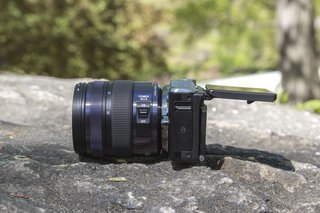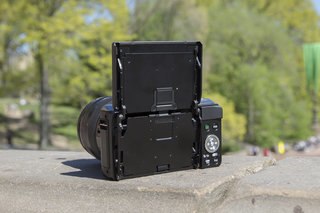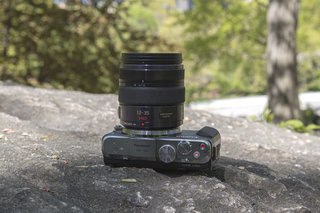Panasonic GF6 Review
Содержание
Panasonic Lumix GF6 Features
One of the key new additions to the Panasonic GF6 – in comparison to its predecessor, the Lumix GF5 – is a newly designed sensor. The GF6 now has a 16MP Live MOS sensor, a considerable 4MP increase on the GF5.
The sensor is paired with a new and upgraded Venus Engine image processor aimed at improving performance at higher ISO settings. The engine promises a two-stage noise reduction process, which will in theory aid this performance, as well as improved dynamic range and colour reproduction.
As is becoming increasingly common with newly released CSCs, the Panasonic GF6 features a full repertoire of connectivity. This includes both Wi-Fi functionality and Near Field Communication (NFC) technology.

The Wi-Fi connectivity in question here allows for both the wireless transfer of images between the GF6 and a Wi-Fi enabled smartphone, tablet or laptop, as well as the remote operation of the camera through a dedicated application.
The NFC connectivity, meanwhile, allows for the simple transfer of images from the camera to similarly NFC-enabled devices through just touching the camera up against the device.
Going back to the new additions found on the GF6, the most obvious of these is most likely the LCD screen found on the rear of the camera. Although it’s the same size as that found on the predecessor, it has a higher resolution of 1040k-dots compared to 920k-dots.
The real development, however, is that it’s now of the vari-angle variety. The screen itself can now be pulled away from the body to tilt downwards at roughly 45 degrees and also flipped upwards at an angle of up to around 180 degrees, and as such can be viewed from in front of the camera.
It’s touch sensitive, too, which allows touch focus, touch focus point selection and touch shutter, as well as full access to the camera’s menu system. There are still a healthy number of physical controls, however, if that’s what you prefer.
As you’d expect for an entry-level CSC, the GF6 maintains a range of shooting options to make taking photos as easy as possible. These include 23 scene modes and 19 creative filter settings, all of which offer impressive effects with just the click of the shutter.
That’s not to say that the GF6 isn’t conducive to advanced image capture – it still includes the full PASM (Program, Aperture, Shutter, Manual) range of manual shooting controls, as well as Raw image capture.
The GF6 also offers full 1,920 x 1,080 HD video capture complete with stereo audio and full-time auto-focus (AF) in either AVCHD or MP4 formats. An advanced manual shooting mode is also on offer during video capture, offering control over shooting settings as well as audio levels.
Digital Production Manager
Paul joined What Digital Camera magazine at the start of 2007 having graduated from the University of Exeter.
He cut his teeth as Staff Writer, before moving on to cover all…
Movie magic
But it’s not all about stills. The GF6 can shoot 1080p movie clips at up to 60 frames per second using AVCHD capture, or 30 frames per second max via MP4. Although the quality may technically be less in the latter option, it’s available for use straight from camera without conversion so we’d recommend it as the option to choose for casual shooters.

But it’s not just the quality which sells the movie mode, its the way it operates so seamlessly via the touchscreen. A press on the screen will shift the focus point, which then slowly glides into focus with no unwanted over or underfocusing. Although it’s not super fast it suits the format, and is particularly effective for smooth transitions between one subject and another.
Autofocus can be switched off and there’s full access to the AFS, AFF, AFC and manual focus options as in stills shooting. In addition to live exposure compensation, there’s also full manual controls which can be adjusted in real time during recording. The only fancy thing that’s missing is a microphone input either, otherwise this is top-notch stuff from an apparently entry level camera.
Verdict
What the GF6 gets right, it gets so brilliantly right that it makes us very happy indeed. The 16-megapixel sensor produces image quality that’s closing the gap between Micro Four Thirds and the larger-sensor competition, while the super-fast autofocus, tilt-angle LCD screen and new mode-dial-featured design certainly have their individual perks. It’s a nod to the original GF1, but brought bang up to date. Movie mode is great too.
We do have our moans though: battery life still isn’t good enough and Wi-Fi further impacts how long the GF6 will last out. If, that is, you ever happen to use the Wi-Fi options as we found them to be long-winded to set up and too locked down to specific services to be of full use. And there’s still no provision to add a viewfinder, but that’s the GF-series legacy so we doubt such a feature will ever be included.

It’s all about context in the end though. For under £500 there are few entry level compact system cameras as fully featured for the cash, even if the Lumix G5 — complete with built-in viewfinder and the same 14-42mm lens — is the very same price. And let’s not forget the more stripped-back feature set of the Sony NEX-3N with 16-50mm power-zoon lens comes in at £360 at the time of writing.
As the GF-series grows so does it continue to strengthen and while the GF6 is the best model yet we’d still like to see a push in core areas such as battery life. The GF6 has got both still image quality and movie mode wrapped up nicely and there are features aplenty — the GF6 will make good sense for those new to photography, as well as others stepping up to the next level or just those wanting something smaller to use.
Introduction
The Panasonic Lumix GF6 is a new small, stylish and cutting-edge compact system camera. The GF6 features a Four Thirds-sized 16 megapixel Live MOS image sensor, Venus Engine processor (the same as that of the range-topping GH3), Light Speed AF system, a hinged touch-sensitive LCD screen which can be rotated by 180°, built-in pop-up flash, integrated Wi-Fi and NFC connectivity, Full HD video recording, 19 Creative Effects and a Creative Panorama mode, stop-motion animations, a Clear Retouch function that allows users to clone out unwanted elements from a photo in-camera, RAW support and an expanded ISO range of 160-25600. The Panasonic GF6 is available in black/silver or white in a kit with the standard Lumix G Vario 14-42mm F3.5-5.6 lens for £499 / $599, and £649 in a double-zoom kit with the 45-150mm Mega O.I.S. telephoto lens.
Self-obsessed
From the off the GF6 looks a little larger than the GF5. In part that’s because it is, but not as much as it may seem to the eye: the body is a mere couple of millimetres larger. It’s the GF6’s inclusion of the latest 14-42mm kit lens in the box which adds the most physical size compared to the pricier power-zoom version that came with the GF5. We don’t mind — in fact we’re pleased — as we find the traditional twist-zoom easier to use and it cuts off around £100 from the price which keeps the GF6 kit to a very sensible £499.
READ: Panasonic Lumix GF5 review

The body’s extra size comes from one important new component: the inclusion of a tilt-angle LCD screen. The 1,040k-dot, 3-inch screen is mounted on a bracket which means it can be pulled away from the body and then angled 45 degrees downwards or a full 180 degrees upwards for a full-on forward-facing position for selfies. Go on, narcissists, that’s your cue to get excited — and pretend that you’re not. It’s very cool.
In use we found it easy to manipulate the screen, although with touchscreen controls activated we’d often end up pressing somewhere on the screen and accidentally repositioning the autofocus point. Goes to show just how sensitive this latest touchscreen is — great when it’s wanted, a bit annoying when it’s not. We also found bright sunlight caused problematic reflections which made assessing exposure a little tricky and, given that there’s no viewfinder, there’s no way around that.

Another big design tweak is the inclusion of a physical mode dial on top of the camera. This isn’t completely new to the series as the original GF1 had a similar dial, but each GF camera since had ditched such control in favour of a more streamlined design. Perhaps the GF6 doesn’t look as refined, but we think the addition of the mode dial is a positive step that will open the camera up to a broader audience — from point-and-shooters through to those who want easy-to-access manual controls.
Wi-Fi lockdown
As tech lovers, the concept of the connected camera always excites us. Until, that is, we try out the various methods of delivery that we’ve seen thus far. Just like the Lumix TZ40 compact camera, the GF6’s Wi-Fi and NFC (near field communication) set-up that can be irksome to use.

It’s all down to passwords. And needing to enter them again and again depending on where you’re trying to share an image quickly becomes long-winded. Although the GF6’s approach isn’t quite as bad as the likes of Canon’s Wi-Fi set-up, it does fall into similar issues — first of all there’s a lot of application downloading to do. Fine for home use where once it’s set up it’s ready to roll again and again, but part of the appeal of NFC is to share with others, and if pairing’s not quick then it might be cause to give up altogether.
READ: Canon EOS 6D review
The list of sharing options does sound attractive — it’s possible to control the camera via your smart device, there’s a playback on TV option and images can be sent in real time or post-shooting to smartphone, PC, cloud (Lumix Club account only), web service or AV device — but there are a few key things missing. Notice how there’s no Facebook, Twitter or the likes of Dropbox? That’s a mistake in our view. We don’t want to be forced into using Lumix Club to share via social media as a secondary point and we doubt many other users do either.

So we like the idea of Wi-Fi and NFC, but it’s not thrilled us in practice. It will have occasional use and is a nice to have but not an essential feature, at least not in this current state. When things simplify — take the Olympus Pen E-P5’s use of QR codes to connect to devices — it will open up a wider world.
READ: Hands-on: Olympus Pen E-P5 review
It’s also worth pointing out the impact on battery life. We had already found the GF6 doesn’t last out all too long in use and using the connected options really doesn’t help. In fact this is the biggest single moan we have with this camera — the battery life just isn’t good enough.
Технические характеристики, заявленные производителем
| Panasonic Lumix DMC-GF6 | |
|---|---|
| Сенсор изображения | 4/3 дюйма Live MOS, общее количество пикселей: 16,68 |
| Эффективное количество точек, Мп | 16 |
| Формат сохранения изображения | Фотокадр: JPEG (EXIF 2.3, DCF), 3D-фото MPO, RAW Видео: MPEG-4, AVCHD |
| Диапазон фокусных расстояний, мм | 14-42 |
| Размер кадра в пикселях | Фотокадр: 4608×3456 (L), 3264×2448 (M), 2336×1752 (S), 1824×1368 (с установленным 3D-объективом), 4608×3072 (L), 3264×2176 (M), 2336×1560 (S), 1824×1216 (с установленным 3D-объективом), 4608×2592 (L), 3264×1840 (M), 1920×1080 (S), 1824×1024 (с установленным 3D-объективом), 3456×3456 (L), 2448×2448 (M), 1744×1744(S), 1712×1712 (с установленным 3D-объективом) Видео: AVCHD 1920×1080, 60i (с сенсора 30p) 1280×720, 60p (с сенсора 30p) MP4 При установке на : 1920×1080 пикселей (30 кадров/с) При установке на : 1280×720 пикселей (30 кадров/с, прибл.) При установке на : 640×480 пикселей |
| Чувствительность, единиц в ISO-эквиваленте | Автоматическая, 160, 200, 400, 800, 1600, 3200, 6400, 12800, 25600 |
| Диапазон выдержек, с | От 60 до 1/4000 |
| Экспозамер | 1728-зонная многозадачная сенсорная система: интеллектуальный многоточечный, центровзвешенный, точечный |
| Экспокоррекция | +/-3 EV с шагом 1/3 EV |
| Встроенная вспышка | Ведущее число 6,3 при ISO 160 |
| Автоспуск, с | 2/10 |
| Устройство хранения информации | SD/SDHC/SDXC |
| ЖК-дисплей | Сенсорный, 7,6 см (3,0 дюйма), разрешением 1040 тыс. точек |
| Интерфейсы | HDMI, USB, AV-выход |
| Питание | Литий-ионный аккумулятор DMW-BLG10E,7,4 Вт*ч |
| Габариты (ШхВхД), мм | 111,2×64,8×38,4 |
| Масса, г | 280 (только камера) |
Комплект поставки
Комплект поставки вполне стандартный для «беззеркалок» начального ценового диапазона — в коробке находятся наплечный ремень, руководство пользователя, диск с дополнительным ПО, USB-кабель, зарядное устройство, а также объектив и аккумулятор. Последние два заслуживают чуть большего внимания. Комплектный объектив новинки стал значительно компактнее, чем у предшественницы. Точнее, это тот же объектив, которым комплектуются малютки GM1/GM5. Его зовут H-FS12032, его масса составляет всего 70 грамм, а в транспортировочном положении он напоминает компактный «фикс», а вовсе не зум-объектив. Аккумулятор неожиданно тоже точно такой же, как и в камерах семейства GM. Он компактный, но и ёмкость его значительно ниже – 4,9 Вт·ч против 7,4 Вт·ч у GF6. А если вспомнить старичка GF5, то у него ёмкость аккумулятора составляла целых 9 Вт·ч. Конечно, благодаря такой обновке GF7 стал значительно компактнее и легче предшественника, но и длительность автономной работы существенно сократилась.
Quality speaks for itself
The 16-megapixel Live MOS sensor at the heart of the GF6 may not be as large as many of its competitors — it’s 50 per cent smaller than the APS-C sensors found in Sony and Samsung compact system cameras — but Panasonic, and the Micro Four Thirds camp as a whole, is doing a fine job of closing the gap. Even though there’s a considerable resolution hike from 12.1-megapixels to 16.1-megapixels, any concern that all these extra pixels would work to the detriment of quality are unfounded. In fact we’re very pleased with the quality that the GF6 can produce.
READ: Samsung NX300 review

Panasonic hasn’t confirmed whether the sensor is the same as that found in the G5, but signs would suggest that it is. And that makes for decent quality throughout a large portion of its ISO 160-12,800 range. It’s a shame there’s no base ISO 50 or 100 setting, but it’s tricky to implement such a readout in most modern sensors. Olympus has seen fit to offer an expanded ISO 100 in the latest E-P5 model, but this comes with limitations to dynamic range. No such setting for the GF6.
READ: Panasonic Lumix G5 review
Although the GF6 won’t outperform most APS-C sized sensors at the higher ISO settings, the gap isn’t as huge as you might think. While we did see a shift in colour in some ISO 3200 shots and detail isn’t as abundant as the richer lower ISO shots, the results are still very pleasing. Up to and including this sensitivity we’d say shots are more than passable — they’re of good quality, save for some blown highlights here and there.

But it’s the lower ISO settings — the ones that will be of most use most of the time — that really impressed us. The ISO 160 setting revealed some super sharp frames and when paired up with the 12-35mm f/2.8 lens we were getting some great soft background effects too.
Even right into the mid ISO settings, such as this sunglasses shot, quality remains high with little impact on overall detail.

As we say, exposure does seem to side with pulling detail out of the shadows and this can mean that highlights blow out fairly easily. Keep an eye on the exposure compensation dial to ensure shots are as you want them, but make sure you exit the exposure compensation option afterwards, as it otherwise takes control of the rear rotational d-pad and makes it all too easy to shoot with a +/-EV by accident. It can be hard to judge this because of reflections on the rear LCD screen so, as a back-up, we’d advise shooting raw where it’s possible to rescue those all important frames should they go a little over.
Overall it’s happy days in the image quality department. Despite some minor moans we’re confident that the GF6 delivers the best GF-series image quality yet and at a higher resolution. It’s even worth upgrading for and not just one for first time buyers.
Внешний вид и удобство использования
По весу и размерам GF7 вплотную приблизилась к GM5, а, например, конкурент от Olympus практически на 100 граммов тяжелее. Впрочем, есть ещё Sony ILCE-5000, который по массогабаритным показателям почти не уступает тестируемому фотоаппарату. Дизайн корпуса значительно изменился относительно GF6: пропал выступ в лицевой части, отдельного ползунка питания в новинке нет, как нет и рычажка управления зумом (который доступен лишь при установке объективов с моторизированным приводом трансфокации). Впрочем, есть и улучшения. Например, клавиша видеозаписи переползла с верхней панели, где она часто попадала под указательный палец вместо клавиши спуска затвора, в более привычное место — в верхний правый угол тыльной поверхности.
 |
 |
|
 |
 |
К качеству сборки претензий нет — все детали подогнаны неплохо, особо неравномерных стыков и больших зазоров в тестовом образце замечено не было, а при попытке скручивания и сдавливания корпус не издал ни малейшего скрипа.

Спереди расположены лишь светодиод подсветки автофокуса и байонет объектива. С тыльной стороны изменений относительно предшественницы чуть больше. Во-первых, тут появилась уже упомянутая выше клавиша видеозаписи, а во-вторых, пропала вторая функциональная клавиша.

Впрочем, расстраиваться по этому поводу рано, ведь если учитывать и виртуальные сенсорные клавиши, то общее количество программируемых клавиш, напротив, стало значительно больше. В остальном всё по-прежнему: большую часть тыльной поверхности занимает дисплей, а в правой части на тонкой полоске уместились кнопки перехода в режим просмотра, входа в быстрое меню (она же удаления и возврата на один уровень назад), смены режима отображения, а также круглая 4-позиционная многофункциональная клавиша навигации, дополненная вращающимся бортиком по периметру и клавишей ввода/входа в основное меню по центру.

Сверху находятся программируемая клавиша, пара микрофонов, подъёмная вспышка, клавиша перехода в автоматический интеллектуальный режим, диск выбора режимов работы, а также кнопка спуска затвора с рычажком питания.

Нижняя часть ничем примечательным не выделяется — тут находится лишь разъём установки на штатив, а также отсеки для аккумулятора и карты памяти, скрытые единой дверцей.
 |
 |
На правой боковой поверхности под резиновой заглушкой прячется пара разъёмов подключения HDMI-, а также USB/AV-кабеля. Левая боковая поверхность вовсе пустовала бы, если бы не три отверстия декоративной решётки системного динамика.
Сравнение характеристик Panasonic Lumix GF7 и Lumix GF6
Panasonic GF7
Panasonic GF6
Дата анонса
20 января 2015
9 апреля 2013
Встроенная стабилизация изображения
нет
нет
Датчик
16 Мп (эффективных)17.3×13.0 ммMicro Four Thirds
ультразвуковой волновой фильтр
16 Мп (эффективных)17.3×13.0 ммMicro Four Thirds
ультразвуковой волновой фильтр
Не было речи об обновлении сенсора для GF7, но16 Мп вполне достаточно для обрезки кадров при редактировании фотографий в графическом редакторе. Вы получите высокую детализацию изображений даже для распечаток среднего и большого размера.
ISO
200 — 25 600
100 (с расширением)
160 — 12 800
25 600 (с расширением)
Формат RAW
есть
есть
Система автофокусировки
система контрастного автофокуса по 23 точкам
режимы: распознавание лиц или глаз, следящий, по 23 зонам, по одной зоне, точечный
диапазон EV: от -4 до 18
система контрастного автофокуса по 23 точкам
режимы: распознавание лиц, следящий автофокус, по 23 зонам, по одной зоне, точечный
диапазон EV: от -3 до 18
Система замера экспозиции
1728-зонная
диапазон: EV 0 — 18
1728-зонная
диапазон: EV 0 — 18
В GF7 более чувствительная система автофокусировки, позволяющая лучше фокусироваться в условиях с недостаточным освещением, а также появился режим распознавания глаз.
LCD-экран
3-дюймовый
1 040 000 точки
сенсорный
откидной на180 градусов
3-дюймовый
1 040 000 точки
сенсорный
откидной на180 градусов
Оба фотоаппарата оснащены экранами с одинаковым высоким разрешением. Но наклонный дисплей в GF7 автоматически активирует несколько селфи-ориентированных функций, например, buddy shutter. В целом и с GF7, и с GF6 можно удобно и просто снимать автопортреты. ЖК-мониторы очень отзывчивы и высококачественны.
Скорость затвора
60 — 1/16 000 сек
60 — 1/4 000 сек
В GF7 гораздо выше максимальная скорость затвора, что даёт преимущества при съёмке движущихся объектов.
Полное ручное управление
да
да
Встроенная вспышка
есть (4 м)
есть (6.3 м)
В GF6 более мощная встроенная вспышка.
Скорость серийной съёмки
5.8 кадров в секунду
4.2 кадра в секунду
С GF7 скорость серийной съёмки немного выше.
Компенсация экспозиции
5 кадров (с шагом 1/3 EV)
± 3 (с шагом 1/3 EV)
Брекетинг экспозиции
±3 (3, 5, 7 кадров с шагом в 1/3 EV, 2/3 EV, 1 EV)
±2 (3, 5 кадров с шагом в 1/3 EV, 2/3 EV)
Запись видео (макс. разрешение)
1080p60
1080p30
1080p24
стереозвук
1080i60
1080p30
стереозвук
В GF7 добавили опцию записи видео 1080p60 (прогрессивная развёртка)
60p означает более высокое качество изображения по сравнению с 60i (кадры с чересстрочной развёрткой), что особенно важно, если вы собираетесь редактировать видео и хотите высокое качество записи.
Вход для микрофона и наушников
нет / нет
нет / нет
Беспроводная связь
Wi-Fi
Wi-Fi + NFC
Hands-Free (свободные руки) для съёмки селфи
да
(автоматическая съёмка после взмаха руками перед фотокамерой или когда два лица находятся близко друг к другу в кадре)
нет
Функция «снимок в прыжке»
есть
нет
Режим «моментальное видео» (Snap Movie Mode)
есть
нет
Встроенный GPS
нет
нет
Габариты
107 х 65 х 33 мм
111 х 65 х 38 мм
Вес
266 г
323 г
Срок службы батареи (CIPA)
230 снимков
340 снимков
Выводы
Системный фотоаппарат GF7 почти на 250 долларов дороже своего предшественника. Большая стоимость предлагает дополнительные преимущества. Среди них: новый корпус в стиле ретро, улучшенные функции для съёмки селфи, более высокое качество Full HD видео, улучшенная производительность автофокусировки в условиях слабого освещения, выше скорость серийной съёмки, шире возможности для удалённого использования фотокамеры, объектив 12-32мм (тот же, что поставлялся с GM5), более компактный и лёгкий корпус.
Хотелось бы в дополнение иметь функцию записи 4K-видео и, пожалуй, электронный видоискатель. Но в целом GF7 выглядит как приятное обновление для любителей фотосъёмки, которым нужен компактный системный фотоаппарат начального уровня.
GF6 может стать лучшим выбором лишь в том случае, если для вас не так важны дополнительные функции из GF7.Мы бы выбрали фотоаппарат Panasonic GF7 (предпочтительно в комплекте с 14-42 мм объективом) за его стильный дизайн и отличные возможности для съёмки автопортретов.
- Panasonic Lumix DMC-GF6 — первая беззеркальная камера с поддержкой Wi-Fi / NFC
- Сравнение беззеркальных фотокамер Lumix DMC-GF6, Lumix DMC-GF5 и Lumix DMC-GH3
28 января, 2015
No slowing down
For our money we’d say that Panasonic’s G-series has the fastest autofocus system of any compact system camera brand. There may well be official figures here and there from competitors that would disagree, but as far as across the board performance goes at different focal lengths in various conditions we’ve got little bad to say about the GF6’s speedy performance.

The camera itself fires up from off in less than half a second and from there it’s possible to nip straight into snapping away. The GF6 is said to have improved autofocus, but it’s such a marginal improvement on an already great system that our far slower brains can’t really tell the difference. It’s one of those blink and you’ll miss it things.
The main area in which Panasonic is said to have improved is autofocus when snapping subjects in low light. The sensor readout is automatically cut from its full 120 frames per second and slowed down to avoid unwanted focus-hunting when the camera detects dark conditions. In practice the benefit is minimal, at least by terms of comparison to the previous generation model. What we do get is autofocus that will either focus or won’t — the given focus point will either say «yes please» or «no thanks» and, in general, we’ve found it to achieve focus in plenty of scenarios, so long as there’s some degree of contrast separation. This honest autofocus feedback is great to have, as it’s more realistic than the likes of, say, the Sony NEX-5R’s generalised approach in low light.
READ: Sony NEX-5R review
The GF6’s autofocus is broken down into a variety of options: there’s a 23-area auto mode among the face detection, AF tracking, 1-area and pinpoint options. Our weapons of choice were the final two, as with 1-area and pinpoint it’s possible to press anywhere on the screen to acquire a specific focus point. The pinpoint option zooms in to a 100 per cent image-sized view to show where the exact focus has been acquired. Panasonic still seems to be the only company offering such a precision system. It’s great for tasks such as shooting through mesh fences or where prominent contrast areas get in the way of the subject you want to pick out from its busy surroundings and shoot.

Single autofocus (AFS) — where the focus depth is confirmed and fixed by a half depression of the shutter — was our preferable focus type, but the GF6 also includes continuous autofocus (AFC) and flexible autofocus (AFF) where the camera will continue to focus at all times, while the latter option acts like AFS but refocuses only if it detects movement within the frame. The results from these are a little mixed, as in low light it’s tricky to follow and successfully shoot a moving subject, while close-up focus tends to «pulse» in and out of focus.
If you don’t know what you want to use and simply want the camera to take over then a single press of the iA — which stands for «intelligent auto» — button on top of the camera will let the GF6 take over, whichever mode happens to be selected on the mode dial. The iA button lights up a fetching blue too, so you’ll know it’s activated — although in bright sunlight this can be a little trickier to spot.
